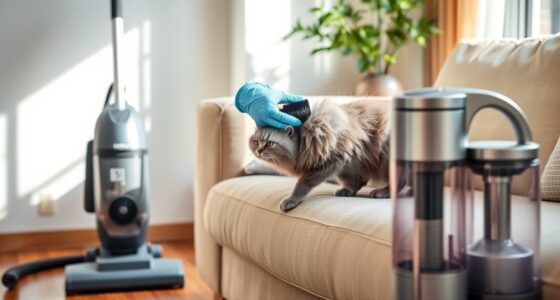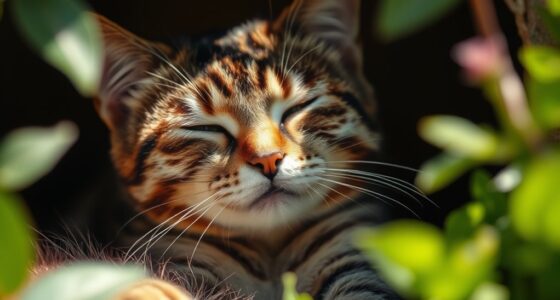When picking a furry companion in the United States, **dogs** and **cats** are still the go-to options for many families. During the year 2024, these beloved pets continue to hold the top spots, showing their strong presence in the pet industry. If you’re thinking about adding a new member to the family, these statistics might just convince you to choose a dog or cat as your next pet!
The most common reasons for pet ownership in the US, particularly for dogs, cats, birds, rodents, and fish, include companionship, emotional support, and the joy and entertainment pets bring to their owners’ lives. Pets are often considered part of the family, with 97% of pet owners viewing their pets as family members. The benefits of having a dog, for example, extend to physical and emotional well-being, as they can help reduce loneliness, are good for the heart, help alleviate stress, and encourage physical activity.
Pet ownership in the US reaches new heights in 2024, accompanied by a significant increase in spending on pet-related products and services.
Did you know the total U.S. pet industry expenditures reached a staggering $136.8 billion in 2022? This figure highlights pet ownership’s immense scale and impact in the United States. From pet food and treats to vet care and various other services, Americans invest more in their furry companions than ever. And the growth doesn’t stop there, with projected sales for 2023 estimated at $143.6 billion. Let’s delve into the latest pet statistics and uncover the trends and insights shaping the pet industry.
Key Takeaways:
- The U.S. pet industry expenditures reached $136.8 billion in 2022.
- Projected sales for 2023 are estimated to reach $143.6 billion.
- Pet food and treats, supplies, vet care, and other services contribute to most pet expenses.
- 66% of U.S. households, totaling 86.9 million households, own a pet.
- Dogs are the most popular pets, followed by cats and freshwater fish.
Pet Statistics in US – Trends & Insights
The latest pet statistics in the United States indicate that many American households own various types of pets, including dogs, cats, birds, reptiles, and fish. According to the American Veterinary Medical Association (AVMA) 2022 Pet Ownership and Demographic Sourcebook, 44.6% of households own dogs, 26% own cats, 2.5% own birds, and 1.4% own reptiles[1]. The total number of dogs in the United States ranges between 83,739,829 and 88,853,254, while cats number between 60,217,861 and 61,910,686. Bird ownership numbers are at approximately 7,538,000, and reptile ownership is estimated at 1.4% of households[1].
- The National Kitten Coalition reports that approximately 3.4 million cats enter animal shelters nationwide every year, with a significant portion being kittens. Of the non-transferred cat intakes for which age was known, 38% were kittens, and 82% of these kittens were adopted[2].
- The Cornell Lab of Ornithology has highlighted a concerning trend of a nearly 30% decline in the population of North American birds since 1970, which translates to almost three billion birds lost[3].
- The Reptile Database provides species numbers as of October 2023, with 5,461 species of lizards (Sauria), 3,315 species of snakes (Serpentes), 317 species of turtles (Testudines), and 27 species of crocodiles (Crocodylia)[4].
- Fisheries statistics are compiled annually by NOAA Fisheries, documenting the importance of fishing to the nation, including recreational and commercial fisheries by species[5].
- MarketWatch has provided insights into pet spending trends, indicating that California is the most expensive state to own dogs, and women spend more on pets compared to men. The survey also found that veterinary care is the largest pet expense reported by respondents[6].
- Cats.com provides an infographic with the latest data on cat statistics, noting that approximately 6.5 million pets find their way into American animal shelters every year, with about half of those being cats. The site also mentions that pet ownership in America has increased by 300%, with 67% of all households in the United States having pets, and 35% of those households owning cats[7].
- Bird statistics from Chirp Nature Center indicate that there are about 18,000 bird species in the world, and the North American bird population has decreased by almost 30% since 1970[8].
- The American Bird Conservancy’s 2022 U.S. State of the Birds Report reveals widespread losses of birds in all habitats except for wetlands, where waterfowl show strong increases due to investments in wetland conservation[12].
- The reptile industry in the United States is valued at approximately $1.5 billion, with over nine million reptiles kept as pets in America[13].
- These statistics provide a comprehensive overview of pet ownership trends and insights into the challenges faced by various pet populations in the United States.
Total U.S. Pet Industry Expenditures
Regarding pet spending in the U.S., the numbers speak volumes. Over the course of five years, from 2018 to 2022, the total U.S. pet industry expenditures have steadily increased, demonstrating the growth and significance of the pet industry in our society. Here is a breakdown of the pet industry expenditures for each year:
- 2018: $90.5 billion
- 2019: $97.1 billion
- 2020: $108.9 billion
- 2021: $123.6 billion
- 2022: $136.8 billion
These figures reveal a consistent upward trend, with each year surpassing the previous one in terms of pet spending. It is clear that pets hold a special place in our hearts and wallets, as we invest more and more in their well-being and happiness.
Pet Spending on the Rise
In a world where pets are considered family members, it’s no surprise that pet spending continues to grow. From essential items like food, grooming, and veterinary care to luxury accessories and services, pet owners are investing heavily in their furry companions. This upward trajectory in pet spending not only reflects the increasing importance of pets in our lives but also fuels the growth of the pet industry as a whole.
“Pets are often seen as part of the family, and people want to provide the best care and products for their beloved companions. This emotional connection leads to increased spending on pets.”
Expert in the pet industry
As the pet industry continues to expand and cater to the evolving needs of pet owners, we can anticipate even greater growth in the years to come.
Complete Table:
| Year | U.S. Pet Industry Expenditures (in billions of dollars) |
|---|---|
| 2018 | 90.5 |
| 2019 | 97.1 |
| 2020 | 108.9 |
| 2021 | 123.6 |
| 2022 | 136.8 |
Breakdown of Pet Expenditures
When it comes to taking care of our beloved pets, there are various expenses to consider. Let’s take a closer look at the breakdown of pet expenditures in the U.S. market in 2022:
| Category | Amount Spent (in billions) |
|---|---|
| Pet Food and Treats | $58.1 |
| Supplies, Live Animals, and OTC Medicine | $31.5 |
| Veterinary Care and Product Sales | $35.9 |
| Other Services (Grooming, Boarding, Insurance, Training, etc.) | $11.4 |
These figures reveal the diverse range of expenses that pet owners incur to ensure the well-being of their furry companions. Now, let’s delve deeper into each category:
Pet Food and Treats:
Pet food and treats account for a significant portion of pet care spending, with an expenditure of $58.1 billion. This includes a wide variety of pet food options catering to different dietary needs and preferences. From kibble to specialized diets, pet owners prioritize providing their pets with wholesome and nutritious meals.
Supplies, Live Animals, and OTC Medicine:
The category of supplies, live animals, and over-the-counter (OTC) medicine encompasses various components of pet ownership. With an expenditure of $31.5 billion, this includes essential supplies such as pet beds, toys, grooming tools, and crates, along with the cost of acquiring live animals and purchasing OTC medicines for minor ailments.
Veterinary Care and Product Sales:
Ensuring the health and well-being of our pets is of utmost importance. This is reflected in the $35.9 billion spent on veterinary care and product sales. From routine check-ups and vaccinations to more extensive medical treatments, pet owners are committed to providing quality healthcare for their furry companions. Additionally, this category includes the purchase of veterinary products like prescription medications and preventive treatments.
Other Services:
Aside from the essentials, pet owners also invest in various other services to enhance their pets’ lives. This could include grooming services, boarding facilities for travel or work commitments, pet insurance to safeguard against unexpected expenses, and training sessions to ensure well-behaved pets. The expenditure in this category amounts to $11.4 billion.

As caring pet owners, we understand the importance of providing our pets with the best care possible. From the food they eat to the medical attention they receive, every aspect of pet care comes together to create a happy and healthy life for our companions.
Pet Ownership in the U.S.
When it comes to pet ownership in the U.S., the numbers are truly astounding. According to the 2023-2024 APPA National Pet Owners Survey, a staggering 66% of U.S. households, totaling 86.9 million households, own a pet. This demonstrates the deep-rooted bond between Americans and their furry companions, highlighting the significance of pets in our daily lives.
“Pets are not just animals; they are part of our family. They bring us joy, companionship, and unconditional love,” says Sarah Johnson, a proud pet owner herself.
Unsurprisingly, dogs reign supreme as the most popular pets in the U.S., with 65.1 million households owning a canine companion. They are followed closely by cats, with 46.5 million households embracing the feline charm. Additionally, 11.1 million households have freshwater fish, adding a touch of tranquility to their homes.
Looking deeper into the demographics, millennials comprise the largest percentage of current pet owners, with a staggering 33% of households in this generation proudly caring for a pet. Generation X follows closely at 25%, while baby boomers account for 24% of pet owners.
| Generation | Percentage of Pet Owners |
|---|---|
| Millennials | 33% |
| Generation X | 25% |
| Baby Boomers | 24% |
Pets Bring Joy and Happiness
Pet ownership is a beautiful experience that enhances our lives in numerous ways. Dogs provide companionship and encourage physical activity, while cats offer comfort and relaxation. Both pets have been scientifically proven to lower stress levels and improve overall mental well-being.
Moreover, the presence of pets in our homes fosters a sense of responsibility and nurturing. Growing up with pets can teach children empathy, compassion, and important life lessons, perpetuating a cycle of love and care for animals.
Through thick and thin, pets are loyal and devoted, standing by our side no matter what. They bring us endless moments of joy and happiness, reminding us why pet ownership is a cherished bond that enriches our lives.

Pet Ownership by Generation
When it comes to pet ownership, different generations have their own preferences and tendencies. According to the survey data, pet ownership varies across different age groups. Let’s take a closer look at pet ownership by generation:
Gen Z (Ages 18-25)
Gen Z pet owners, who fall between the ages of 18 and 25, are known for their love of variety. They are more likely to own a diverse range of pets, including cats, dogs, small animals, and even reptiles. This generation embraces the idea of having various furry or scaly companions as part of their lives.
Millennials (Ages 26-41)
Millennials, also referred to as Gen Y, make up the largest percentage of current pet owners. They have a deep connection with their pets and often consider them as family members. Cats and dogs are popular choices among millennials, and they are known for their willingness to invest in pet care products and services to provide the best for their furry friends.
Gen X (Ages 42-57)
In contrast to Gen Z and millennials, Gen X pet owners, aged between 42 and 57, are the least likely to own pets other than cats and dogs. They tend to stick to traditional pet options and may have a preference for more established pet breeds and species. Gen X pet owners prioritize the companionship and loyalty that cats and dogs offer.
Baby Boomers (Ages 58-76)
Baby boomers, born between 1946 and 1964, also have a strong affinity for pets, particularly cats and dogs. They value the emotional support and companionship that pets provide, especially as they enter their retirement years. Baby boomers are known to be dedicated pet owners, often spoiling their furry companions with love and attention.
Understanding the different patterns of pet ownership by generation helps us recognize the diverse ways in which pets enrich our lives. Whether it’s embracing a variety of pets in Gen Z, treating pets as family members for millennials, sticking to traditional pet options for Gen X, or finding companionship in pets during retirement for baby boomers, the bond between humans and their pets continues to bring joy and fulfillment.
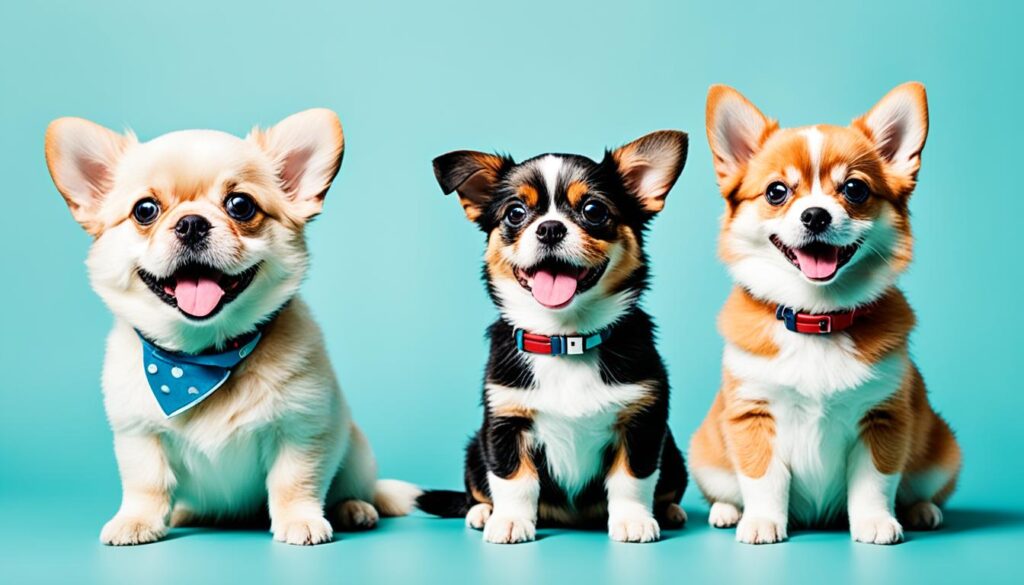
Stay tuned for the next section, where we’ll explore the most popular pets in the U.S. and their unique characteristics.
Popular Pets in the U.S.
When it comes to popular pets in the United States, two contenders take the spotlight: dogs and cats. Dogs hold the title as the most beloved pets in the country, with a staggering 65.1 million households proudly calling them family members. Cats, on the other hand, come in a close second, with 46.5 million households opening their homes to these graceful creatures.
While dogs and cats dominate the pet ownership scene, they aren’t the only choices for animal enthusiasts. Numerous households delight in the companionship of other pets, such as freshwater fish, small animals like hamsters and rabbits, and even colorful birds.
Yet, it is the enduring bond between humans and their canine or feline friends that truly captures our hearts. Let’s explore the enduring appeal of dogs and cats in more detail:
The Loyal and Loving Dogs
Dogs have long been known as loyal companions who offer unconditional love and affection. They have a remarkable ability to form deep emotional connections with their owners, making them popular choices for families and individuals seeking unwavering companionship.
Dogs also come in an impressive array of breeds, each with their own unique traits and personalities. From the playful and energetic Labrador Retrievers to the elegant and regal German Shepherds, there is a dog breed to suit every lifestyle and preference.
The Mysterious and Independent Cats
Cats, on the other hand, possess a certain air of mystery and independence that captivates many pet owners. These graceful creatures have a knack for balancing their affectionate side with an innate desire for autonomy. Cat lovers appreciate their enigmatic nature and the joy of earning their trust and companionship.
With countless breeds to choose from, cat owners can revel in the diversity of sizes, coat colors, and personalities. From the graceful Siamese cats to the gentle Maine Coons, each breed brings its own unique charm and beauty to the mix.
“A dog will be your loyal companion, while a cat will be your enigmatic confidant.”
Throughout history, dogs and cats have been cherished as loyal friends and beloved family members. Their unwavering love, companionship, and ability to bring joy into our lives make them the top contenders in the realm of popular pets in the U.S.
| Pets | Number of Households |
|---|---|
| Dogs | 65.1 million |
| Cats | 46.5 million |
| Freshwater Fish | 11.1 million |
| Small Animals (Hamsters, Rabbits, etc.) | Varies |
| Birds | Varies |
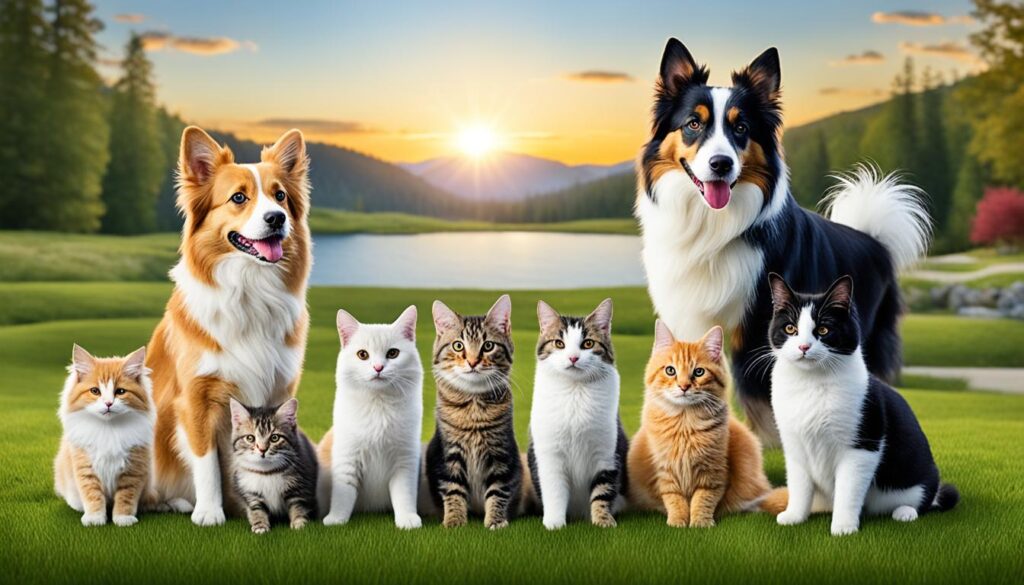
Cost of Pet Ownership
Owning a pet comes with financial responsibilities. As pet owners, we need to be prepared for the various expenses associated with providing proper care and ensuring the well-being of our beloved companions.
Expense Breakdown for Dogs and Cats
When it comes to pet expenses, it’s important to note that the average amount spent can differ between dog and cat owners. Let’s take a closer look at the breakdown:
| Expense Category | Dog Owners | Cat Owners |
|---|---|---|
| Veterinary Care | $600 – $1,800 per year | $400 – $1,200 per year |
| Food | $300 – $900 per year | $200 – $600 per year |
| Grooming | $30 – $500 per year | N/A |
| Toys | $50 – $200 per year | $100 – $300 per year |
These estimates reflect a range of potential expenses and can vary based on factors such as the pet’s size, specific health needs, and individual preferences.
“Properly budgeting for pet ownership helps ensure we can provide the necessary care and meet our pets’ needs.”
Annual Expenses for Dog Owners
On average, dog owners can expect to spend around $1,533 per year on their furry companions. This includes expenses such as veterinary care, food, grooming, toys, and other miscellaneous items. However, it’s essential to note that these figures are approximate and can vary based on location, lifestyle, and the specific needs of your dog.
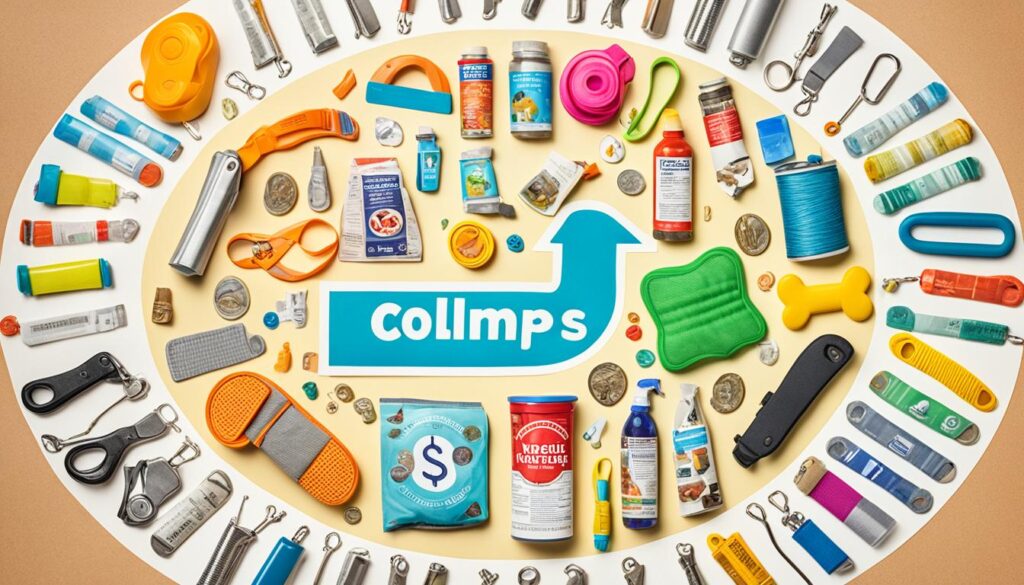
Investing in our pets’ well-being is a priority, and budgeting for their care helps ensure that we can provide the love and attention they deserve. Whether it’s regular check-ups at the vet, high-quality food, or engaging toys, each expense contributes to their overall health and happiness.
By understanding the financial responsibilities that come with pet ownership, we can make informed decisions and provide the best possible care for our furry family members.
Rise in Pet Insurance
When it comes to taking care of our beloved pets, their health and well-being are top priorities. That’s why the popularity of pet insurance has been steadily rising, providing pet owners with peace of mind and financial security. As of 2022, over 4.8 million pets are insured, a clear indication of the increasing awareness and importance of pet insurance.
Pet insurance plays a crucial role in safeguarding against unexpected veterinary expenses. It covers a range of treatments, from routine check-ups to emergency surgeries, ensuring that the best care is accessible when it’s needed most. With the rising costs of veterinary care, having pet insurance in place can help alleviate the financial burden and enable pet owners to make decisions based on their pets’ needs rather than cost.
One of the main reasons for the increase in pet insurance is the growing awareness among pet owners about the benefits it offers. Pet insurance provides coverage for accidents, illnesses, and even preventive care, enabling pet owners to provide comprehensive healthcare for their furry companions. It allows pet owners to make informed decisions regarding their pets’ medical treatment without worrying about the associated costs.
“Pet insurance provides a safety net for pet owners, allowing them to focus on what matters most – the health and well-being of their pets.”
Another factor contributing to the rise in pet insurance is the evolving role of pets in our lives. Pets have become more than just animals; they are cherished members of our families. As pet owners, we strive to give them the best care possible, which includes access to quality healthcare. Pet insurance enables us to provide that level of care without compromising our financial stability.
As the demand for pet insurance continues to grow, insurance providers are expanding their coverage options and tailoring policies to meet the diverse needs of pet owners. From basic accident and illness coverage to comprehensive plans that include preventive care and alternative therapies, there is a wide range of options available. This allows pet owners to choose a plan that aligns with their budget and their pet’s specific healthcare requirements.
Pet insurance is no longer seen as a luxury but rather a necessity for responsible pet ownership. Whether it’s a young puppy or a senior cat, having pet insurance ensures that our furry friends receive the care they deserve throughout their lives. So, if you haven’t considered pet insurance yet, now is the time to explore your options and give your pet the protection they deserve.
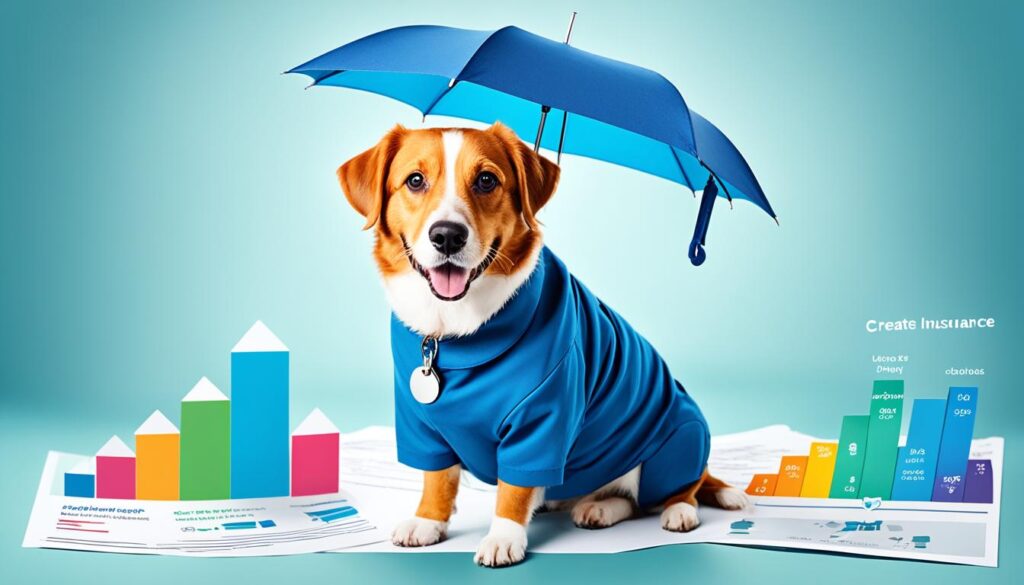
Next, let’s explore the demographics of pet ownership and the role income plays in the decision to own a pet.
Pet Ownership Demographics
Understanding the demographics of pet ownership provides valuable insights into the preferences and behaviors of pet owners. According to the latest survey conducted by the American Pet Products Association (APPA), pet ownership correlates with income and housing status.
Households with annual incomes of $100,000 and over are more likely to own pets. In this income bracket, 63% of households own dogs, while 40% own cats. This suggests that higher income levels contribute to increased pet ownership, possibly due to the ability to provide more resources and a higher quality of care for their furry companions.
Furthermore, homeowners are more likely to own pets compared to renters. The stability and freedom provided by homeownership may make it easier to accommodate and care for pets. Renters, on the other hand, may face more restrictions or additional costs associated with pet ownership in rental properties.
Pet Ownership Demographics by Income
| Income Bracket | Dog Ownership | Cat Ownership |
|---|---|---|
| Under $50,000 | 41% | 18% |
| $50,000 – $99,999 | 51% | 23% |
| $100,000 and over | 63% | 40% |
The table above provides a more detailed breakdown of pet ownership by income bracket. As income increases, so does the likelihood of owning a pet, particularly dogs. However, it’s important to note that pets bring joy and companionship to individuals and families across all income levels.
Overall, understanding the demographics of pet ownership aids in tailoring products, services, and educational resources to better serve the diverse needs and preferences of pet owners.
Increasing Pet Expenditures
We have witnessed a steady increase in pet expenditures in the U.S. over the years, indicating a growing trend of pet spending. From $90.5 billion in 2018 to $136.8 billion in 2022, the pet industry has experienced significant growth. And the good news is that this upward trajectory is projected to continue, with estimated sales reaching $143.6 billion in 2023.
This surge in pet expenditures reflects the increasing importance of pets in our lives and the expanding range of products and services available to cater to their needs. As pet owners, we are investing more in ensuring their well-being, health, and happiness.
Whether it’s high-quality food, premium grooming services, advanced veterinary care, or the latest pet gadgets, we are willing to go the extra mile to provide the best for our beloved furry companions.
This growing trend in pet spending not only boosts the pet industry but also has a positive impact on the economy as a whole. It drives innovation, creates job opportunities, and fuels the growth of businesses dedicated to catering to the diverse needs of pet owners.
“The increasing pet expenditures signify the deep bond between pets and their owners, demonstrating our commitment to their well-being and happiness.”
As the pet industry continues to flourish, both pet owners and industry players can expect more exciting developments and advancements that will further enhance the lives of our furry friends.
Pet Expenditures Comparison
| Year | Total Expenditures (in billions) |
|---|---|
| 2018 | $90.5 |
| 2019 | $97.1 |
| 2020 | $108.9 |
| 2021 | $123.6 |
| 2022 | $136.8 |
| 2023 (projected) | $143.6 |
This table provides a clear comparison of pet expenditures from 2018 to 2022, highlighting the consistent growth in the pet industry. The projected sales for 2023 further signify the positive trajectory and potential for continued expansion.

With increasing pet expenditures, the future looks bright for pet owners and the pet industry alike. As we continue to prioritize the well-being and happiness of our pets, we can expect to see even more innovative products and services that cater to their ever-evolving needs.
Dog Owner Regrets
According to a Forbes Advisor survey, 54% of dog owners have regrets about owning a dog. While dogs bring joy and companionship into our lives, it’s important to recognize that being a dog owner comes with its challenges. Let’s explore the top challenges associated with dog ownership:
- Cleaning up after the dog: Dogs require regular walks and bathroom breaks, which means cleaning up their waste. This task can be time-consuming and unpleasant for some dog owners.
- Finding care when traveling or working: Dog owners often face the challenge of finding reliable care for their pets when they need to travel or work long hours. Arranging for dog sitters or doggy daycare can be stressful and costly.
- Training: Dogs need proper training to ensure they are well-behaved and obedient. This requires time, patience, and consistent effort from the dog owner. Training challenges can range from basic commands to more complex behaviors.
- Cost of vet bills: Veterinary care is essential for keeping dogs healthy, but it can be costly. From routine check-ups to unexpected illnesses or injuries, vet bills can add up quickly, causing financial strain for some dog owners.
Despite these challenges, the love and companionship that dogs bring into our lives often outweigh the regrets. With proper planning, training, and budgeting, dog ownership can be a rewarding experience.
“Owning a dog is not just a privilege, it’s a responsibility. It requires commitment, patience, and an understanding of the challenges that come with it. But the love and loyalty you receive from your dog make it all worthwhile.” – Anonymous
Cost of Vet Bills
A significant concern for pet owners is the cost of vet bills. A survey reveals that 42% of pet owners cannot cover a surprise vet bill of $999 or less without going into debt. This emphasizes the importance of pet insurance as a way to mitigate these financial burdens.

Pet insurance provides financial security for unexpected vet expenses, ensuring that pet owners can afford the necessary medical care for their furry friends. By paying a monthly premium, pet owners can protect themselves from the potentially high costs of veterinary treatments, surgeries, and medications.
Not only does pet insurance alleviate the financial strain of vet bills, but it also allows pet owners to make decisions about their pet’s health based on the best medical recommendations rather than financial limitations. With the rising cost of vet care, having insurance coverage can provide peace of mind and ensure that pets receive the care they need.
Here is an example of how pet insurance can help with unexpected vet expenses:
| Expense | Cost | |
|---|---|---|
| Vet Consultation | $50 | |
| Medication | $100 | |
| X-rays | $200 | |
| Surgery | $500 | |
| Total | $850 |
Without pet insurance, the pet owner would be responsible for the entire $850 bill. However, with insurance coverage, the out-of-pocket expenses would be significantly reduced, depending on the policy.
It’s important for pet owners to carefully review and compare different pet insurance options to find the best plan that suits their needs and budget. Factors to consider include coverage limits, deductibles, reimbursement percentages, waiting periods, and exclusions.
In conclusion, investing in pet insurance can provide financial protection and peace of mind when it comes to managing the cost of vet bills and unexpected vet expenses. By considering pet insurance as part of the overall cost of pet ownership, pet owners can provide the best care for their beloved pets without the worry of overwhelming veterinary costs.
Most Expensive Cities for Dog Owners
An analysis by Forbes Advisor reveals the most expensive cities for dog owners. These cities have higher costs associated with pet care, making it more expensive for dog owners to provide for their furry friends. The top five cities on the list are:
- Winston-Salem, North Carolina
- Greensboro, North Carolina
- Bakersfield, California
- El Paso, Texas
- Memphis, Tennessee
In these cities, dog owners face higher expenses related to veterinary care, boarding, and other dog-related services. The cost of dog ownership may vary depending on factors such as the availability of affordable veterinary clinics, the presence of pet-friendly amenities, and the overall cost of living.
It’s important for dog owners in these cities to budget and plan accordingly to ensure they can provide the best care for their furry companions without breaking the bank.
Understanding the Costs of Dog Ownership in Expensive Cities
“Living in one of the most expensive cities for dog owners can present unique challenges. The cost of vet care, boarding, and other dog-related expenses can add up quickly. It’s essential to consider these costs and plan ahead to ensure you can provide the necessary care for your dog while still managing your overall budget.”
While the expenses may be higher in these cities, it’s important to remember the rewards of dog ownership. Dogs bring joy, love, and companionship, making them cherished members of many families. With proper planning and budgeting, dog owners in these cities can still provide a happy and fulfilling life for their furry friends.

An image illustrating the challenges and costs faced by dog owners in expensive cities.
Pet Industry Growth and Future Outlook
The pet industry has experienced consistent growth, with expenditures reaching $136.8 billion in 2022. This upward trend is projected to continue in the future, with estimated sales of $143.6 billion in 2023. The steady increase in pet industry spending reflects the growing significance of pets in our lives, as well as the expanding range of products and services available to pet owners.
Pet ownership is no longer just about providing basic necessities; it has become a lifestyle choice that encompasses various aspects of our daily lives. From premium pet food and treats to innovative pet care products, pet owners are willing to invest more in their pets’ well-being and happiness.
Furthermore, the pet industry has witnessed significant advancements in pet health care, including advanced veterinary services, preventive care, and pet insurance. These developments have not only improved the quality of life for pets but have also given pet owners peace of mind when it comes to unexpected vet expenses.
Another driving force behind the pet industry growth is the increasing focus on pet-centric services and experiences. Pet owners are seeking out unique and personalized services, such as pet grooming, training, and daycare, to enhance their pets’ overall lifestyle. This demand has led to the emergence of specialized businesses catering to the unique needs and preferences of pet owners.
The future outlook for the pet industry remains promising, with continued growth and innovation on the horizon. As the bond between humans and pets deepens, we can expect to see further advancements in pet products, services, and technologies. From smart pet gadgets to personalized nutrition plans, the pet industry will continue to evolve to meet the ever-changing demands of pet owners.
“The future of the pet industry is bright, as more and more people recognize the importance of pets in their lives. With the rising trend of pet humanization, we can expect to see increased spending on premium pet products and services, further boosting the growth of the industry.” – Pet Industry Expert
Trends Shaping the Future of the Pet Industry
- The rise of e-commerce and online pet marketplaces, offering convenience and a wide range of options to pet owners.
- The increasing influence of social media platforms in promoting pet products and services, driving consumer engagement and brand loyalty.
- Growing demand for sustainable and eco-friendly pet products, reflecting a shift towards conscious consumerism.
- The incorporation of technology in pet care, including wearable devices and telemedicine, improving the overall well-being of pets.
- The expanding pet demographic, with younger generations embracing pet ownership and prioritizing pets as integral members of their families.
With these trends and an optimistic outlook, the pet industry is poised for continued growth, cementing its position as a vital sector in the overall economy.
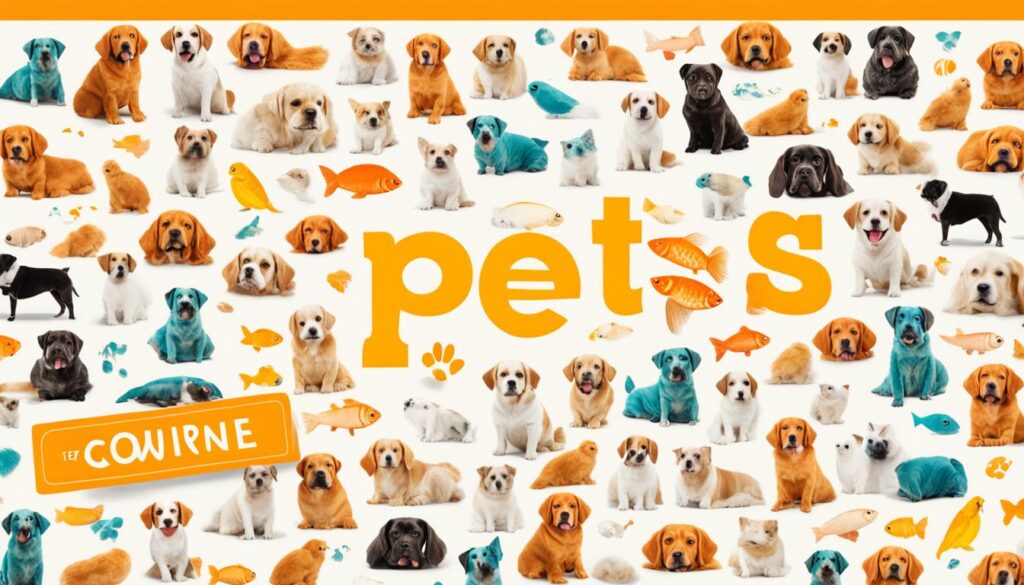
Conclusion
In conclusion, the latest pet statistics in the U.S. reveal a thriving pet industry and a significant number of pet owners. The increasing expenditures on pets reflect their importance as integral members of our families.
As pet ownership continues to rise, it is crucial to consider the financial responsibilities and challenges that come with providing the best care for our furry friends. Whether it is budgeting for food, vet care, or insurance, being prepared for the costs associated with pet ownership is essential.
Key takeaways from the data include the steady growth of the pet industry, with projected sales of $143.6 billion in 2023. Additionally, dog and cat ownership remains the most popular choice for households, with millennials leading the way as the largest percentage of pet owners. Finally, the rise in pet insurance highlights the increasing recognition of the importance of financial protection when it comes to unexpected vet bills.
FAQ
What are the total U.S. pet industry expenditures?
What is the breakdown of pet expenditures in the U.S. market?
How many households in the U.S. own a pet?
How does pet ownership vary across different generations?
What are the most popular pets in the U.S.?
What are the average expenses for dog owners?
What are the total U.S. pet industry expenditures?
What is the breakdown of pet expenditures in the U.S. market?
How many households in the U.S. own a pet?
How does pet ownership vary across different generations?
What are the most popular pets in the U.S.?
What are the average expenses for dog owners?
FAQ
What are the total U.S. pet industry expenditures?
The total U.S. pet industry expenditures have been steadily increasing in recent years. In 2022, 6.8 billion was spent on pets in the U.S., with the majority of the expenditure going towards pet food and treats, supplies and medications, vet care and products, as well as various other services. The projected sales for 2023 indicate further growth in the industry, reaching a total of 3.6 billion.
What is the breakdown of pet expenditures in the U.S. market?
The breakdown of pet expenditures in the U.S. market in 2022 includes: .1 billion for pet food and treats, .5 billion for supplies, live animals, and OTC medicine, .9 billion for vet care and product sales, and .4 billion for other services such as grooming, boarding, insurance, and training. These figures highlight the diverse range of expenses incurred in taking care of our pets.
How many households in the U.S. own a pet?
According to the 2023-2024 APPA National Pet Owners Survey, 66% of U.S. households, totaling 86.9 million households, own a pet. The most popular pets are dogs (65.1 million households), followed by cats (46.5 million households), and freshwater fish (11.1 million households). Millennials make up the largest percentage of current pet owners at 33%, followed by Gen X at 25% and baby boomers at 24%.
How does pet ownership vary across different generations?
The data from the same APPA survey indicates that pet ownership varies across different generations. Gen Z pet owners (ages 18 to 25) are more likely to have a variety of pets, while Gen X pet owners (ages 42 to 57) are the least likely to own pets other than cats and dogs.
What are the most popular pets in the U.S.?
Dogs are the most popular pets in the U.S., with 65.1 million households owning a dog. Cats come in second, with 46.5 million households owning a cat. Additionally, there are millions of households that own freshwater fish, small animals like hamsters and rabbits, and birds.
What are the average expenses for dog owners?
Owning a pet comes with financial responsibilities. The average amount spent on various pet categories differs for dogs and cats. For example, dog owners spend more on veterinary care, food, and grooming, while cat owners spend more on food, veterinary care, and toys. The estimated annual expenses for dog owners can amount to
FAQ
What are the total U.S. pet industry expenditures?
The total U.S. pet industry expenditures have been steadily increasing in recent years. In 2022, $136.8 billion was spent on pets in the U.S., with the majority of the expenditure going towards pet food and treats, supplies and medications, vet care and products, as well as various other services. The projected sales for 2023 indicate further growth in the industry, reaching a total of $143.6 billion.
What is the breakdown of pet expenditures in the U.S. market?
The breakdown of pet expenditures in the U.S. market in 2022 includes: $58.1 billion for pet food and treats, $31.5 billion for supplies, live animals, and OTC medicine, $35.9 billion for vet care and product sales, and $11.4 billion for other services such as grooming, boarding, insurance, and training. These figures highlight the diverse range of expenses incurred in taking care of our pets.
How many households in the U.S. own a pet?
According to the 2023-2024 APPA National Pet Owners Survey, 66% of U.S. households, totaling 86.9 million households, own a pet. The most popular pets are dogs (65.1 million households), followed by cats (46.5 million households), and freshwater fish (11.1 million households). Millennials make up the largest percentage of current pet owners at 33%, followed by Gen X at 25% and baby boomers at 24%.
How does pet ownership vary across different generations?
The data from the same APPA survey indicates that pet ownership varies across different generations. Gen Z pet owners (ages 18 to 25) are more likely to have a variety of pets, while Gen X pet owners (ages 42 to 57) are the least likely to own pets other than cats and dogs.
What are the most popular pets in the U.S.?
Dogs are the most popular pets in the U.S., with 65.1 million households owning a dog. Cats come in second, with 46.5 million households owning a cat. Additionally, there are millions of households that own freshwater fish, small animals like hamsters and rabbits, and birds.
What are the average expenses for dog owners?
Owning a pet comes with financial responsibilities. The average amount spent on various pet categories differs for dogs and cats. For example, dog owners spend more on veterinary care, food, and grooming, while cat owners spend more on food, veterinary care, and toys. The estimated annual expenses for dog owners can amount to $1,533 on average.
How popular is pet insurance?
The popularity of pet insurance has been on the rise, with over 4.8 million pets insured as of 2022. Pet insurance provides financial security for unexpected vet bills and is becoming a common choice among pet owners.
What are the demographics of pet ownership?
The APPA survey highlights that households with annual incomes of $100,000 and over are more likely to own pets, with 63% of households in this income bracket owning dogs and 40% owning cats. Homeowners are also more likely to own pets compared to renters.
How have pet expenditures in the U.S. been changing over the years?
The sources show that pet expenditures in the U.S. have been steadily increasing over the years. From $90.5 billion in 2018 to $136.8 billion in 2022, the pet industry has experienced significant growth. This trend is expected to continue, with projected sales of $143.6 billion in 2023.
What are the top challenges associated with dog ownership?
According to a Forbes Advisor survey, 54% of dog owners have regrets about owning a dog. The top challenges associated with dog ownership include cleaning up after the dog, finding care when traveling or working, training, and the cost of vet bills.
How do pet owners handle unexpected vet bills?
A significant concern for pet owners is the cost of vet bills. A survey reveals that 42% of pet owners cannot cover a surprise vet bill of $999 or less without going into debt. This emphasizes the importance of pet insurance as a way to mitigate these financial burdens.
Which are the most expensive cities for dog owners?
An analysis by Forbes Advisor reveals the most expensive cities for dog owners. Winston-Salem, North Carolina, tops the list, followed by Greensboro, North Carolina; Bakersfield, California; El Paso, Texas; and Memphis, Tennessee. Factors contributing to the cost include vet care, boarding, and other dog-related expenses.
How has the pet industry been growing?
The pet industry has shown consistent growth, with 2022 expenditures reaching $136.8 billion. Projections for 2023 indicate further growth, with estimated sales of $143.6 billion. This positive trajectory reflects the increasing importance of pets in our lives and the expanding range of products and services available to pet owners.
,533 on average.
How popular is pet insurance?
The popularity of pet insurance has been on the rise, with over 4.8 million pets insured as of 2022. Pet insurance provides financial security for unexpected vet bills and is becoming a common choice among pet owners.
What are the demographics of pet ownership?
The APPA survey highlights that households with annual incomes of 0,000 and over are more likely to own pets, with 63% of households in this income bracket owning dogs and 40% owning cats. Homeowners are also more likely to own pets compared to renters.
How have pet expenditures in the U.S. been changing over the years?
The sources show that pet expenditures in the U.S. have been steadily increasing over the years. From .5 billion in 2018 to 6.8 billion in 2022, the pet industry has experienced significant growth. This trend is expected to continue, with projected sales of 3.6 billion in 2023.
What are the top challenges associated with dog ownership?
According to a Forbes Advisor survey, 54% of dog owners have regrets about owning a dog. The top challenges associated with dog ownership include cleaning up after the dog, finding care when traveling or working, training, and the cost of vet bills.
How do pet owners handle unexpected vet bills?
A significant concern for pet owners is the cost of vet bills. A survey reveals that 42% of pet owners cannot cover a surprise vet bill of 9 or less without going into debt. This emphasizes the importance of pet insurance as a way to mitigate these financial burdens.
Which are the most expensive cities for dog owners?
An analysis by Forbes Advisor reveals the most expensive cities for dog owners. Winston-Salem, North Carolina, tops the list, followed by Greensboro, North Carolina; Bakersfield, California; El Paso, Texas; and Memphis, Tennessee. Factors contributing to the cost include vet care, boarding, and other dog-related expenses.
How has the pet industry been growing?
The pet industry has shown consistent growth, with 2022 expenditures reaching 6.8 billion. Projections for 2023 indicate further growth, with estimated sales of 3.6 billion. This positive trajectory reflects the increasing importance of pets in our lives and the expanding range of products and services available to pet owners.
How popular is pet insurance?
What are the demographics of pet ownership?
How have pet expenditures in the U.S. been changing over the years?
What are the top challenges associated with dog ownership?
How do pet owners handle unexpected vet bills?
Which are the most expensive cities for dog owners?
How has the pet industry been growing?
How popular is pet insurance?
What are the demographics of pet ownership?
How have pet expenditures in the U.S. been changing over the years?
What are the top challenges associated with dog ownership?
How do pet owners handle unexpected vet bills?
Which are the most expensive cities for dog owners?
How has the pet industry been growing?
What Are the Latest Trends and Insights in Guinea Pig Care in the US in 2024?
In 2024, the latest trend in Guinea Pig care in the US is the inclusion of safe Brussels sprouts for guinea pigs in their diet. Guinea pig owners are increasingly aware of the nutritional benefits of this vegetable and are incorporating it into their pets’ meals for a well-balanced diet.
Source Links
- https://www.americanpetproducts.org/research-insights/industry-trends-and-stats
- https://www.forbes.com/advisor/pet-insurance/pet-ownership-statistics/
- https://www.americanpetproducts.org/news/News-Public-Relations/pet-industry-market-size-trends-ownership-statistics
Citations:
[1] https://www.avma.org/resources-tools/reports-statistics/us-pet-ownership-statistics
[2] https://kittencoalition.org/news-events/statistics/
[3] https://www.birds.cornell.edu/home/bring-birds-back/
[4] http://www.reptile-database.org/db-info/SpeciesStat.html
[5] https://www.fisheries.noaa.gov/national/sustainable-fisheries/fisheries-united-states
[6] https://www.marketwatch.com/guides/pet-insurance/pet-ownership-statistics/
[7] https://cats.com/cat-statistics
[8] https://chirpforbirds.com/avian-inspiration/12-bird-statistics-thatll-get-you-squawking/
[9] https://www.ncbi.nlm.nih.gov/pmc/articles/PMC8001315/
[10] https://www.statista.com/topics/1258/pets/
[11] https://petpedia.co/cat-statistics/
[12] https://abcbirds.org/news/2022-state-of-the-birds-press-release/
[13] https://www.petage.com/trends-and-products-cold-blooded-creatures/
[14] https://www.thezebra.com/resources/research/pet-ownership-statistics/
[15] https://www.forbes.com/advisor/pet-insurance/pet-ownership-statistics/
[16] https://www.audubon.org/news/2022-us-state-birds-report-reveals-widespread-losses-birds-all-habitats-except
[17] https://www.freedoniagroup.com/packaged-facts/pet-reptile-products-us-pet-market-trends-and-opportunities
[18] https://www.aspca.org/helping-people-pets/shelter-intake-and-surrender/pet-statistics
[19] https://www.statista.com/statistics/198102/cats-in-the-united-states-since-2000/
[20] https://www.allaboutbirds.org/news/a-third-of-american-adults-are-birdwatchers-according-to-nationwide-survey/
[21] https://www.nature.com/articles/s41586-022-04664-7
[22] https://financesonline.com/number-of-dogs-in-the-us/
[23] https://www.alleycat.org/resources/sources-of-cats-in-u-s-households/
[24] https://www.washingtonpost.com/climate-environment/interactive/2024/bird-population-decline-united-states-maps/
[25] https://reptile-database.reptarium.cz
[26] https://www.iii.org/fact-statistic/facts-statistics-pet-ownership-and-insurance
[27] https://ebird.org/region/US/regions
[28] https://www.zippia.com/reptile-keeper-jobs/demographics/
[29] https://petpedia.co/dog-statistics/
[30] https://www.avma.org/news/giving-reptiles-and-amphibians-best-medicine





